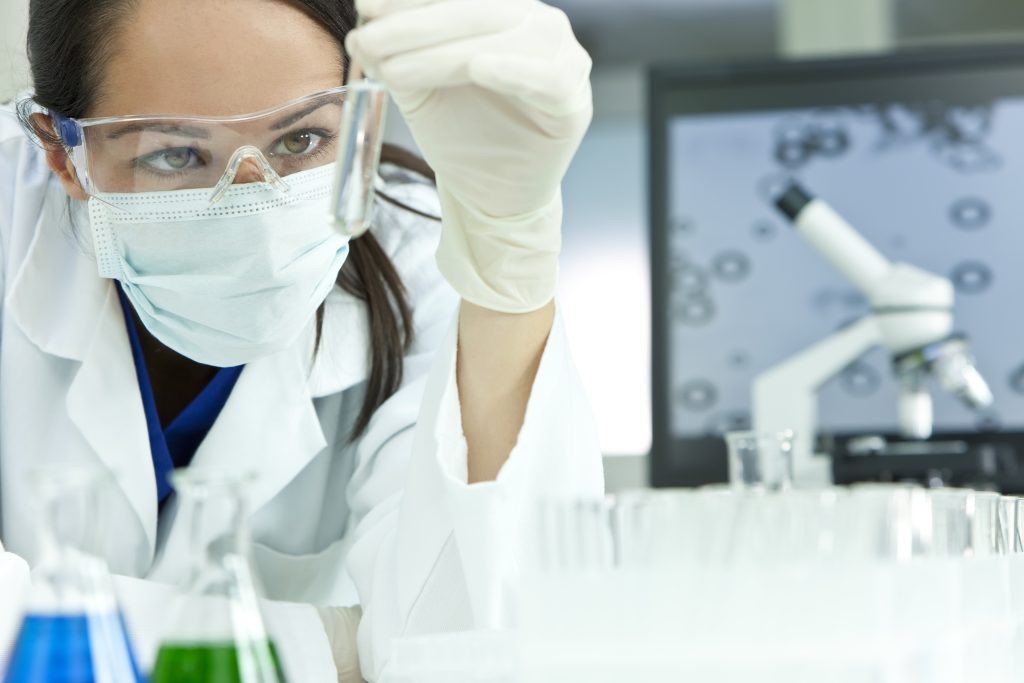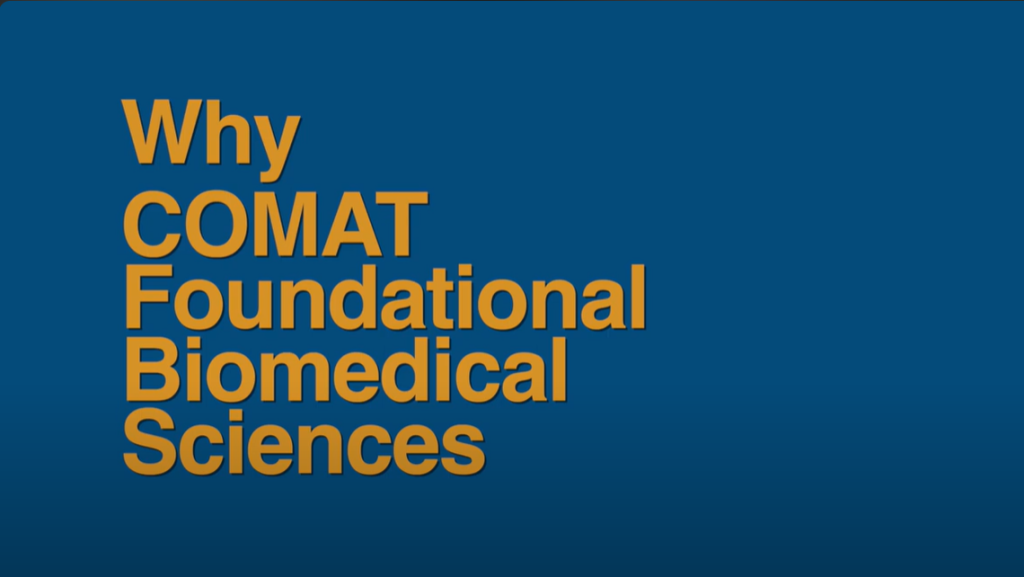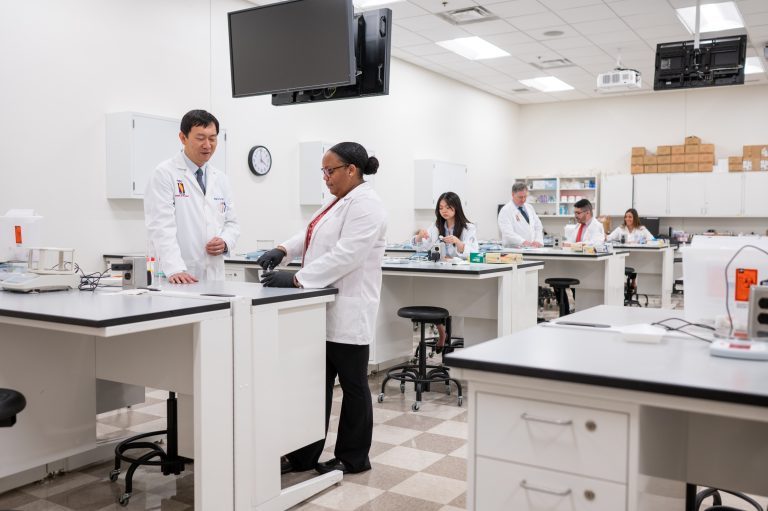
Due to scheduled maintenance on Friday, December 5, from 6 pm to 9 pm EST, the NBOME website may experience an outage. We apologize for any inconvenience.

The COMAT FBS Comprehensive (COMAT FBS-C) is a summative and formative assessment designed to evaluate knowledge of foundational biomedical sciences among first- and second-year osteopathic medical students in advance of taking COMLEX-USA Level 1. It may also be used by schools and colleges of osteopathic medicine (COMs) for formative purposes.

COMAT FBS-C is given in two, 2-hour sessions with 100 items in each session. Between each session is an optional break, the length of which is at the discretion of each COM. Unused test time from section 1 will not be added to section 2.
The FBS-C exam is offered in multiple forms, all of which are psychometrically equivalent in content covered, level of difficulty, and reliability, allowing COMs to administer FBS-C exams multiple times per year.
Michael L. Smith, PhD, year 1 curriculum director and director of multidisciplinary programs at the Texas College of Osteopathic Medicine, discusses how COMAT-FBS can help schools measure student progress toward COMLEX-USA Level 1.



The FBS-C examination may be used for end-of-course assessment for students enrolled at a school or college of osteopathic medicine (COM). Individual COMs may also administer the examination at other times in accordance with their curriculum goals and mission.
This examination emphasizes core knowledge and elements of osteopathic principles and practice in the foundational biomedical sciences disciplines that are essential for the predoctoral osteopathic medical student.
The exam blueprint below contains the FBS topics covered in two dimensions: Dimension 1 – Body Systems and Dimension 2 – Disciplines.
Dimension 1: Body Systems
| Topic | Percentage |
|---|---|
| Human Development, Reproduction, and Sexuality | 3-9% |
| Endocrine System and Metabolism | 8-12% |
| Nervous System and Mental Health | 10-15% |
| Musculoskeletal System | 8-12% |
| Genitourinary/Renal System | 6-10% |
| Gastrointestinal (GI) System and Nutritional Health | 8-12% |
| Cardiovascular and Hematologic Systems | 10-15% |
| Respiratory System | 9-14% |
| Integumentary System | 3-6% |
| Foundational Biomedical Principles | 12-17% |
Dimension 2: Disciplines Blueprint
| Topic | Percentage |
|---|---|
| Biochemistry and Genetics | 12-20% |
| Foundational Anatomical Sciences | 12-20% |
| Microbiology and Immunology | 12-20% |
| Physiologic Basis of Health and Disease | 12-20% |
| Pharmacologic Principles and Concepts | 12-20% |
| Foundational Neurosciences | 12-20% |
Based on the general learner-centered objectives outlined in the FBS examination blueprint, the examinee will be required to demonstrate the ability to apply:
Please note that selected specific learning elements are included for disciplines only due to the overlap between these learning elements and what would be included with body systems.
In addition to the aforementioned objectives, examples of supplementary resources used by the NBOME to inform the development of the FBS exams are listed below.
| Title | Author/Editor | Edition | Year |
|---|---|---|---|
| Atlas of Anatomy | Gilroy, et al. | 4th | 2020 |
| Atlas of Human Anatomy | Netter | 7th | 2019 |
| Snell’s Clinical Anatomy by Regions | Wineski | 10th | 2019 |
| Essentials of Physical Medicine and Rehabilitation: Musculoskeletal Disorders, Pain, and Rehabilitation | Frontera & Silver | 4th | 2020 |
| Gray’s Anatomy for Students | Drake, Vogl, & Mitchell | 4th | 2019 |
| Gray’s Anatomy: the Anatomical Basis of Clinical Practice | Standring | 42nd | 2020 |
| Histology: A Text and Atlas | Pawlina & Ross | 8th | 2018 |
| Junquiera’s Basic Histology Text and Atlas | Mescher | 16th | 2022 |
| Langman’s Medical Embryology | Sadler | 14th | 2018 |
| Clinically Oriented Anatomy | Moore, Dalley, & Agur | 9th | 2022 |
| Neuroanatomy through Clinical Cases | Blumenfeld | 3rd | 2021 |
| Title | Author/Editor | Edition | Year |
|---|---|---|---|
| Harper’s Illustrated Biochemistry | Rodwell, et al. | 32nd | 2022 |
| Lippincott Illustrated Reviews: Biochemistry | Ferrier | 8th | 2021 |
| Mark’s Basic Medical Biochemistry | Lieberman & Marks | 6th | 2022 |
| Medical Genetics | Jorde, Carey, & Bamshad | 6th | 2019 |
| Thompson & Thompson Genetics in Medicine | Nussbaum | 9th | 2019 |
| Title | Author/Editor | Edition | Year |
|---|---|---|---|
| AccessMedicine | Numerous titles | ||
| Current Medical Diagnosis & Treatment | Papadakis & McPhee | 61st | 2022 |
| Cecil Textbook of Medicine | Goldman & Schafer | 26th | 2019 |
| DynaMed Plus | Regularly updated | ||
| Textbook of Family Medicine | Rakel | 9th | 2016 |
| Harrison’s Principles of Internal Medicine | Jameson, Fauci, Kasper, Hauser, Longo, & Loscalzo | 21st | 2022 |
| Nelson’s Textbook of Pediatrics | Kliegman & Geme | 21st | 2019 |
| Essentials of Obstetrics and Gynecology | Hacker | 6th | 2016 |
| Tintinalli’s Emergency Medicine: A Comprehensive Study Guide | Tintinalli et al. | 9th | 2019 |
| Diagnostic and Statistical Manual of Mental Disorders (DSM) | APA | 5th (DSM-5) | 2013 |
| Synopsis of Psychiatry | Kaplan & Saddock | 12th | 2021 |
| Title | Author/Editor | Edition | Year |
|---|---|---|---|
| Jawetz, Melnick, and Adelberg’s Medical Microbiology | Riedel, Morse, Mietzner, & Miller | 28th | 2019 |
| Medical Microbiology | Murray, Rosenthal, & Pfaller | 9th | 2020 |
| Principles and Practice of Infectious Diseases; Volume 1 & 2 | Bennett, Dolin, & Blaser | 9th | 2019 |
| Principles and Practice of Infectious Diseases; Volume 2 | Mandell, Bennett, & Dolin | 9th | 2019 |
| The Sanford Guide to Antimicrobial Therapy | Gilbert, Eliopoulos, & Chambers | 48th | 2018 |
| Cellular and Molecular Immunology | Abbas, Lichtman, and Pillai | 10th | 2021 |
| Immunology | Male, Peebles, & Male | 9th | 2020 |
| Janeway’s Immunobiology | Murphy & Weaver | 10th | 2022 |
| Title | Author/Editor | Edition | Year |
|---|---|---|---|
| Basic Clinical Neuroscience | Young, Young, Tolbert | 3rd | 2015 |
| The Central Nervous System | Brodal | 5th | 2016 |
| Snell’s Clinical Neuroanatomy | Splittgerber | 8th | 2018 |
| Essential Neuroscience | Siegel & Sapru | 4th | 2018 |
| Fundamental Neuroscience | Haines & Mihailoff | 5th | 2017 |
| Neuroanatomy Atlas in Clinical Context | Haines | 10th | 2018 |
| Neuroanatomy through Clinical Cases | Blumenfeld | 3rd | 2021 |
| Adams and Victor’s Principles of Neurology | Ropper, Samuels, Klein, & Prasad | 11th | 2019 |
| Bradley and Daroff’s Neurology in Clinical Practice; Volumes 1 & 2 | Jankovic, Mazziotta, Pomeroy, & Daroff | 8th | 2021 |
| Localization in Clinical Neurology | Brazis, Masdeu, & Biller | 7th | 2016 |
| Orthopaedic Neurology: A Diagnostic Guide to Neurologic Levels | Hoppenfeld & Hoppenfeld | 2nd | 2017 |
| Practical Neurology | Biller | 5th | 2019 |
| Title | Author/Editor | Edition | Year |
|---|---|---|---|
| Basic and Clinical Pharmacology | Katzung | 15th | 2020 |
| Drug Facts and Comparisons | Kastrup | 70th | 2016 |
| Goodman & Gilman’s The Pharmacological Basis of Therapeutics | Brunton, Chabner, & Knollman | 14th | 2022 |
| Lippincott’s Illustrated Reviews: Pharmacology | Whalen, Radhakrishnan, & Feild | 8th | 2022 |
| Pharmacotherapy: A Pathophysiologic Approach | Dipiro, Talbert, Yee, Matzke, Wells, & Posey | 11th | 2020 |
| Stahl’s Essential Psychopharmacology | Stahl | 5th | 2021 |
| Title | Author/Editor | Edition | Year |
|---|---|---|---|
| Berne & Levy Physiology | Koeppen, Stanton | 7th | 2018 |
| Ganong’s Review of Medical Physiology | Barrett, Barman, Yuan, & Brooks | 26th | 2019 |
| Guyton and Hall Textbook of Medical Physiology | Hall & Hall | 14th | 2020 |
| Medical Physiology | Boron & Boulpaep | 3rd | 2016 |
| Physiology | Costanzo | 7th | 2021 |
The NBOME uses many supplementary resources to inform the development of the FBS exams, some of which are listed below.
| Title | Author/Editor | Edition | Year |
|---|---|---|---|
| Atlas of Anatomy | Gilroy, et al. | 4th | 2020 |
| Atlas of Human Anatomy | Netter | 7th | 2019 |
| Snell’s Clinical Anatomy by Regions | Wineski | 10th | 2019 |
| Essentials of Physical Medicine and Rehabilitation: Musculoskeletal Disorders, Pain, and Rehabilitation | Frontera & Silver | 4th | 2020 |
| Gray’s Anatomy for Students | Drake, Vogl, & Mitchell | 4th | 2019 |
| Gray’s Anatomy: the Anatomical Basis of Clinical Practice | Standring | 42nd | 2020 |
| Histology: A Text and Atlas | Pawlina & Ross | 8th | 2018 |
| Junquiera’s Basic Histology Text and Atlas | Mescher | 16th | 2022 |
| Langman’s Medical Embryology | Sadler | 14th | 2018 |
| Clinically Oriented Anatomy | Moore, Dalley, & Agur | 9th | 2022 |
| Neuroanatomy through Clinical Cases | Blumenfeld | 3rd | 2021 |
| Title | Author/Editor | Edition | Year |
|---|---|---|---|
| Harper’s Illustrated Biochemistry | Rodwell, et al. | 32nd | 2022 |
| Lippincott Illustrated Reviews: Biochemistry | Ferrier | 8th | 2021 |
| Mark’s Basic Medical Biochemistry | Lieberman & Marks | 6th | 2022 |
| Medical Genetics | Jorde, Carey, & Bamshad | 6th | 2019 |
| Thompson & Thompson Genetics in Medicine | Nussbaum | 9th | 2019 |
| AccessMedicine | Numerous titles | ||
| Current Medical Diagnosis & Treatment | Papadakis & McPhee | 61st | 2022 |
| Cecil Textbook of Medicine | Goldman & Schafer | 26th | 2019 |
| DynaMed Plus | Regularly updated | ||
| Textbook of Family Medicine | Rakel | 9th | 2016 |
| Harrison’s Principles of Internal Medicine | Jameson, Fauci, Kasper, Hauser, Longo, & Loscalzo | 21st | 2022 |
| Nelson’s Textbook of Pediatrics | Kliegman & Geme | 21st | 2019 |
| Essentials of Obstetrics and Gynecology | Hacker | 6th | 2016 |
| Tintinalli’s Emergency Medicine: A Comprehensive Study Guide | Tintinalli et al. | 9th | 2019 |
| Diagnostic and Statistical Manual of Mental Disorders (DSM) | APA | 5th (DSM-5) | 2013 |
| Synopsis of Psychiatry | Kaplan & Saddock | 12th | 2021 |
| Title | Author/Editor | Edition | Year |
|---|---|---|---|
| Jawetz, Melnick, and Adelberg’s Medical Microbiology | Riedel, Morse, Mietzner, & Miller | 28th | 2019 |
| Medical Microbiology | Murray, Rosenthal, & Pfaller | 9th | 2020 |
| Principles and Practice of Infectious Diseases; Volume 1 & 2 | Bennett, Dolin, & Blaser | 9th | 2019 |
| Principles and Practice of Infectious Diseases; Volume 2 | Mandell, Bennett, & Dolin | 9th | 2019 |
| The Sanford Guide to Antimicrobial Therapy | Gilbert, Eliopoulos, & Chambers | 48th | 2018 |
| Cellular and Molecular Immunology | Abbas, Lichtman, and Pillai | 10th | 2021 |
| Immunology | Male, Peebles, & Male | 9th | 2020 |
| Janeway’s Immunobiology | Murphy & Weaver | 10th | 2022 |
| Basic Clinical Neuroscience | Young, Young, Tolbert | 3rd | 2015 |
| The Central Nervous System | Brodal | 5th | 2016 |
| Snell’s Clinical Neuroanatomy | Splittgerber | 8th | 2018 |
| Essential Neuroscience | Siegel & Sapru | 4th | 2018 |
| Fundamental Neuroscience | Haines & Mihailoff | 5th | 2017 |
| Neuroanatomy Atlas in Clinical Context | Haines | 10th | 2018 |
| Neuroanatomy through Clinical Cases | Blumenfeld | 3rd | 2021 |
| Adams and Victor’s Principles of Neurology | Ropper, Samuels, Klein, & Prasad | 11th | 2019 |
| Bradley and Daroff’s Neurology in Clinical Practice; Volumes 1 & 2 | Jankovic, Mazziotta, Pomeroy, & Daroff | 8th | 2021 |
| Localization in Clinical Neurology | Brazis, Masdeu, & Biller | 7th | 2016 |
| Orthopaedic Neurology: A Diagnostic Guide to Neurologic Levels | Hoppenfeld & Hoppenfeld | 2nd | 2017 |
| Practical Neurology | Biller | 5th | 2019 |
| Title | Author/Editor | Edition | Year |
|---|---|---|---|
| Basic and Clinical Pharmacology | Katzung | 15th | 2020 |
| Drug Facts and Comparisons | Kastrup | 70th | 2016 |
| Goodman & Gilman’s The Pharmacological Basis of Therapeutics | Brunton, Chabner, & Knollman | 14th | 2022 |
| Lippincott’s Illustrated Reviews: Pharmacology | Whalen, Radhakrishnan, & Feild | 8th | 2022 |
| Pharmacotherapy: A Pathophysiologic Approach | Dipiro, Talbert, Yee, Matzke, Wells, & Posey | 11th | 2020 |
| Stahl’s Essential Psychopharmacology | Stahl | 5th | 2021 |
| Title | Author/Editor | Edition | Year |
|---|---|---|---|
| Berne & Levy Physiology | Koeppen, Stanton | 7th | 2018 |
| Ganong’s Review of Medical Physiology | Barrett, Barman, Yuan, & Brooks | 26th | 2019 |
| Guyton and Hall Textbook of Medical Physiology | Hall & Hall | 14th | 2020 |
| Medical Physiology | Boron & Boulpaep | 3rd | 2016 |
| Physiology | Costanzo | 7th | 2021 |
“Medical School Core Curriculum in Genetics.” Association of Professors of Human and Medical Genetics. 2013.
“General Principles of Foundational Science: Microbial biology. Immune System.” USMLE Content Outline (pp. 3-5). National Board of Medical Examiners. 2015.
“Knowledge Objectives in Medical Pharmacology.” Association of Medical School Pharmacology Chairs. 2012.
“Medical Physiology Learning Objectives.” The American Physiological Society and the Association of Chairs of Departments of Physiology. 2012.